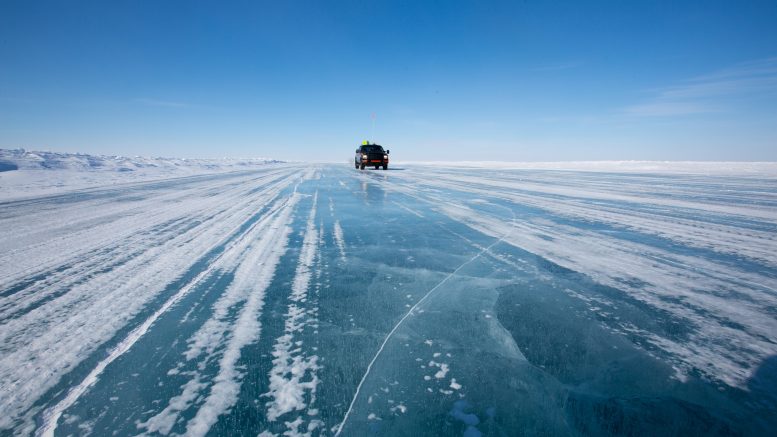The Northwest Territories’ Minister of Industry, Tourism, Investment and Infrastructure, Wally Schumann, came to the Prospectors & Developers Association of Canada (PDAC) convention in Toronto with a message for the rest of Canada. He believes the Northwest Territories (NWT) contains a trove of untapped mineral potential, but lacks the funding to build the infrastructure to unlock it.
“We had a survey done about a year ago,” Schumann says in an interview with The Northern Miner on the sidelines of the convention. “Eighty-six per cent of NWT residents support mining. We have a strong jurisdiction on mining, but our biggest problem is our infrastructure deficit.”
Schumann says he is asking Canada’s federal government to help fund two all-weather highways.
The first would connect the unfinished Mackenzie Valley highway to Sahtu, an area prospective for natural gas and oil. Schumann says it’s also an area that remains underexplored for mineral development — in part because of the historic focus on oil and gas — and he believes it holds a lot of potential. If completed, the Mackenzie Valley highway would connect communities in the NWT from Wrigley in the Dehcho region to the Arctic coast.
Currently, miners and mineral explorers in the NWT largely rely on winter roads for site access.
“What people don’t realize is that’s $20 million a year that melts in April,” Schumann says.
An independent study conducted in 2009 by consulting company Terra Firma investigated the economics of the highway, including the reduced economic activity from not having to build a winter road each year. It notes, however, that in the long-term the highway could benefit the region by promoting tourism; reducing freight costs and therefore lowering consumer prices; and promoting mineral and gas exploration and development.

“I’m proud to say the government of the Northwest Territories and the Indigenous governments of the Northwest Territories are far ahead of the rest of the country.”
Wally Schumann
Minister of Industry, Tourism, Investment and Infrastructure, The Northwest Territories
Schumann also wants to see an all-weather highway that connects the Slave geological province with Nunavut’s Grays Bay Road and Port Project (GBRP). The GBRP is an incomplete 227 km all-season road linking the northern terminus of the Tibbitt-Contwoyto Winter Road to a deep-water port at Grays Bay on the Northwest Passage. Nunavut’s aim for the highway is to “connect the rich mineral resources of Canada’s Slave geological province, which straddles Nunavut and the Northwest Territories, to Arctic shipping routes.”
In previous statements made by Schumann to the NWT government, he asserted that an all-weather road to the Slave geological province would encourage mineral exploration and help extend the life of existing mines in the region.
“I always say to everybody that it would change the GDP of Canada,” Schumann says. “This geological province is as rich if not richer than the Ring of Fire in Ontario. If we don’t have this type of investment in our territory that stuff’s going to be locked in the ground forever.”
Schumann was elected to the NWT’s legislative assembly in 2015 and then selected for cabinet as the minister of transportation and minister of environment and natural resources. In 2016 he became the minister of industry, tourism and investment, and in 2017 became the territory’s first minister of infrastructure. Prior, he was president and vice-president of the Hay River Metis government council.
“I’ve actually been on both sides,” he says. “And I’m probably one of the few politicians in this whole country who’s been on both sides of this issue.”
Still, he says that since becoming minister, the biggest obstacles he’s encountered trying to grow the NWT’s mining industry is the lack of knowledge about the territory and its residents that he encounters from people who don’t live there.
“You’re continuously educating people every day on where we are and what we do and what’s there,” he says. “But the other side of it is a lot of people didn’t even know devolution took place.”
The Northwest Territories Devolution Act came into effect on April 1, 2014, and gave more control from the federal government to the NWT government over land and resources. The act includes a revenue sharing plan that aims to “ensure that Northwest Territories’ residents and Aboriginal groups directly benefit from the responsible development of the region’s resource potential.”
“I’m proud to say the government of the Northwest Territories and the Indigenous governments of the Northwest Territories are far ahead of the rest of the country,” Schumann says. “And I remind Canada all the time to look at the Northwest Territories and how we do this because we are unique compared to the rest of the country.”
The NWT operate on a government-to-government basis and have bilateral agreements with Indigenous governments who have settled their land claims. Indigenous groups who have signed on to devolution also receive 25% of the royalties from resources produced in the Northwest Territories.
“We can’t move stuff through our territory without their participation,” Schumann says.

A map of the highways in the Northwest Territories. Credit: NWT Department of Transportation.
Another challenge Schumann faces is the sentiment that the NWT “should be a park.” Schumann is adamant that this is not what residents actually want. He thinks a lot of the anti-mining, pro-park sentiment comes from people who live in cities outside the NWT, or even outside Canada, trying to push a political agenda centered on environmental protection and climate change. However, Schumann says no one is more aware of the realities of climate change than residents of the Northwest Territories, who deal with it every day.
“Our temperatures have already warmed by four degrees,” Schumann says. “We see shoreline erosion. We have different species moving north. There are invasive species coming, changing the landscape around caribou and all sorts of things.”

The airstrip at Nighthawk Gold’s Colomac gold project in the Northwest Territories. Credit: Nighthawk Gold.
Schumann says he doesn’t think it is fair for other people to decide what the Northwest Territories should be. According to estimates from Statistics Canada, mining, along with oil and gas industries, accounted for $938 million of the NWT’s $3.75 billion 2016 gross domestic product. Schumann says that NWT residents are well aware of the resource industry’s value and encourages any company interested in the resource sector to use his administration as a first point of contact for exploring the region.
“We can help introduce them to the right folks,” Schumann says. “We have lots of parks already, so we need to focus on our economy — because parks ain’t feeding people.”





Be the first to comment on "PDAC 2018: NWT Minister Schumann appeals for federal infrastructure investment"